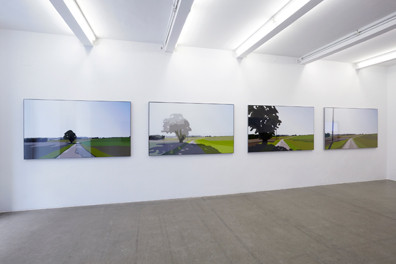Julian Opie
07 Jun - 27 Jul 2013
JULIAN OPIE
7 June - 27 July 2013
Julian Opie’s landscapes are illustrations of real-life locations, integrated into his works as moving or still elements. The reduction of the form is based in the abstraction of the 20th century, which he subjects to even greater changes with the help of computer technology. This approach can also be linked to the tradition of Japanese colour woodcuts from the first half of the 19th century, which have the same silhouette-like features found in Opie’s works. In his exhibition at the Austrian Museum of Applied Arts in Vienna in 2008, for example, Opie presented his animation Eight Views of Japan, which was reminiscent of landscape woodblock prints by Utagawa Hiroshige (1797-1858) whose works are part of the Collection of the British Museum and have influenced Opie’s approach to this field. Opie in fact travelled through the Japanese countryside to find inspiration for his works in which he has often integrated the commonly reproduced motif of Mount Fuji.
The current exhibition at the Krobath Gallery features Opie’s latest landscapes as stills or animations, which allude to the barely perceivable changes in a landscape. Here, the flatness of the environment reflects the green meadows stretching for kilometres and the serpentine grey roads, generating the sense of emptiness that can be felt in such environments.
The animated landscapes are hooked in endless loops, intensifying the feeling of monotony. In detailed takes, Opie examines computer-animated trees moving in subtle motion sequences on LCD screens. The portrait format of these works – entitled Apple Tree, Evening Sun and Shooting Star – symbolises the connection to the illustrated landscape, and the varying hues of sky blue contrast with the green fields in the landscape format paintings.
The works also display elements of 19th century landscape painting, which examine the immediacy of nature-related notions of the idyllic, depicting nature in its pristine form, untouched by human hand. Moreover, Opie’s landscapes are influenced by the work of Dutch painter Jacob Isaakszoon van Ruisdael, one of the most influential 17th Century landscape painters from Haarlem. His work relates especially to woodland scenes and the meticulous rendering of tree details, which is also found in Opie’s work. Hence, Opie draws on such art history traditions, yet deconstructs them using his trademark computer-aided style and scrutinises their very essence. Current tools like Google Maps and Google Earth as well as built-in computer games help to stimulate the creation of environments that synthesise painterly tradition with current forms of digital visualisation. Slow-motion helps to make the works oscillate between still and moving images, which often creates a trompe-l’œil effect that triggers a more thorough look at the works. Being calm and contemplative, these works may be said to convey the feelings of the beholder when viewing the landscape.
Walter Seidl
(English translation: Mandana Taban)
7 June - 27 July 2013
Julian Opie’s landscapes are illustrations of real-life locations, integrated into his works as moving or still elements. The reduction of the form is based in the abstraction of the 20th century, which he subjects to even greater changes with the help of computer technology. This approach can also be linked to the tradition of Japanese colour woodcuts from the first half of the 19th century, which have the same silhouette-like features found in Opie’s works. In his exhibition at the Austrian Museum of Applied Arts in Vienna in 2008, for example, Opie presented his animation Eight Views of Japan, which was reminiscent of landscape woodblock prints by Utagawa Hiroshige (1797-1858) whose works are part of the Collection of the British Museum and have influenced Opie’s approach to this field. Opie in fact travelled through the Japanese countryside to find inspiration for his works in which he has often integrated the commonly reproduced motif of Mount Fuji.
The current exhibition at the Krobath Gallery features Opie’s latest landscapes as stills or animations, which allude to the barely perceivable changes in a landscape. Here, the flatness of the environment reflects the green meadows stretching for kilometres and the serpentine grey roads, generating the sense of emptiness that can be felt in such environments.
The animated landscapes are hooked in endless loops, intensifying the feeling of monotony. In detailed takes, Opie examines computer-animated trees moving in subtle motion sequences on LCD screens. The portrait format of these works – entitled Apple Tree, Evening Sun and Shooting Star – symbolises the connection to the illustrated landscape, and the varying hues of sky blue contrast with the green fields in the landscape format paintings.
The works also display elements of 19th century landscape painting, which examine the immediacy of nature-related notions of the idyllic, depicting nature in its pristine form, untouched by human hand. Moreover, Opie’s landscapes are influenced by the work of Dutch painter Jacob Isaakszoon van Ruisdael, one of the most influential 17th Century landscape painters from Haarlem. His work relates especially to woodland scenes and the meticulous rendering of tree details, which is also found in Opie’s work. Hence, Opie draws on such art history traditions, yet deconstructs them using his trademark computer-aided style and scrutinises their very essence. Current tools like Google Maps and Google Earth as well as built-in computer games help to stimulate the creation of environments that synthesise painterly tradition with current forms of digital visualisation. Slow-motion helps to make the works oscillate between still and moving images, which often creates a trompe-l’œil effect that triggers a more thorough look at the works. Being calm and contemplative, these works may be said to convey the feelings of the beholder when viewing the landscape.
Walter Seidl
(English translation: Mandana Taban)

